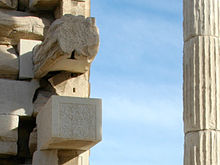Anathyrosis

Anathyrosis (fem., Also anathyrosis , from the Greek θύρα - the door) is the expression for a certain technical processing of connecting surfaces on ancient stone architecture in Greek and Roman construction . The bearing and joint surfaces had to be worked as precisely as possible on stone structures where the stone blocks were placed directly on top of one another without mortar and without any other leveling materials. In order to limit the effort required for this, connecting surfaces were only finely smoothed and leveled in a narrow edge strip (called the edge of the anathyrosis) along the visible surfaces or the outer edges of the block. The inner area of the connection surfaces, referred to as the mirror, on the other hand, was machined slightly deeper with a coarser tool in order to avoid that a tight joint was not achieved due to protruding points.
In rectangular construction, this technique was mainly used on abutting surfaces, while for reasons of stability the interior of the bearing surfaces was usually not deepened, but was often worked out a little more coarsely - with a pointed iron and not with a toothed iron . The term anathyrosis is generally not used for this very similar treatment. Occasionally, processing with anathyrosis can also be observed on storage areas, especially when using dense stone material that is therefore difficult to process and stable, such as marble column drums or pier shafts .
Careful observation of this technical detail can provide information about where a component was located within a building or whether other stones were in association with it.
literature
- Ernst Robert Fiechter : Anathyrosis . In: Paulys Realencyclopadie der classischen Antiquity Science (RE). Supplement volume III, Stuttgart 1918, Col. 96-98.
- Wolfgang Müller-Wiener : Greek construction in antiquity . CH Beck, Munich 1988, pp. 75-76, 90. ISBN 3-406-32993-4